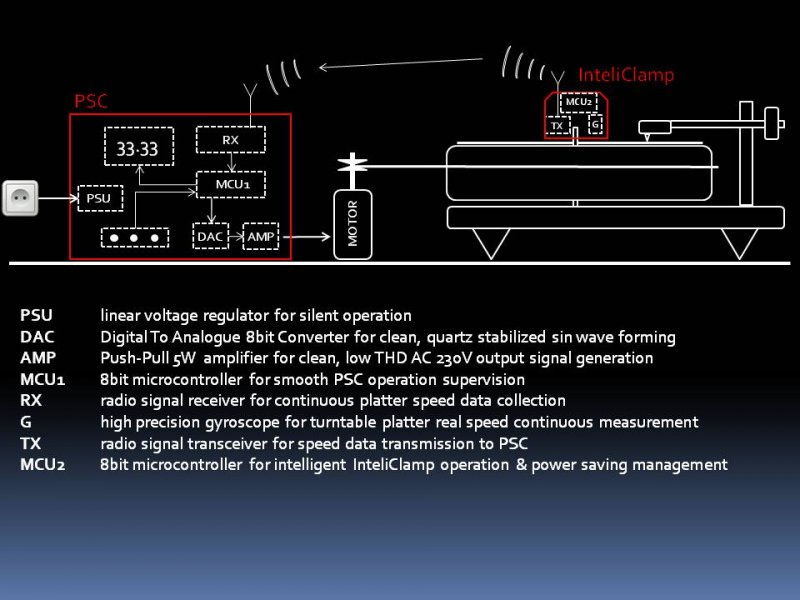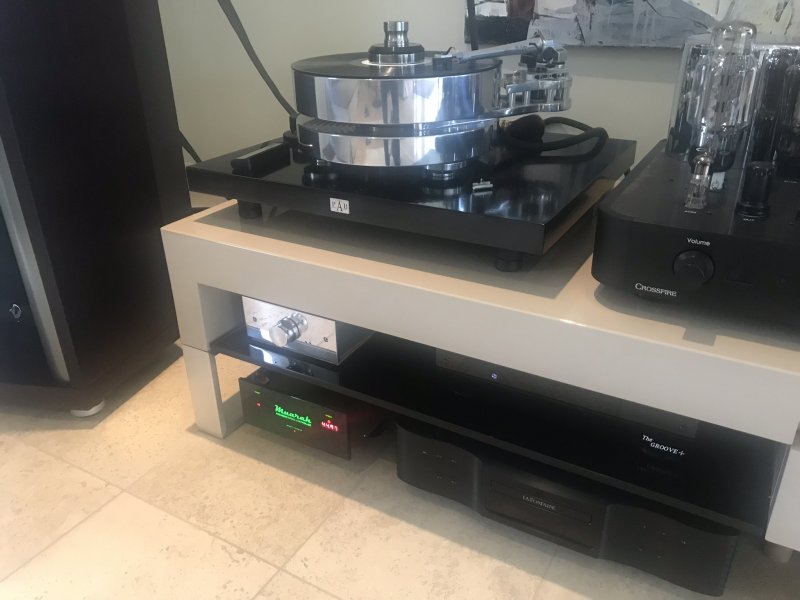The onset of Change and rate of change of the correction will determine if it is “hard” or “soft”. Too abrupt and it is more likely to be audible.What is "soft response"?
Your Web site speaks about 'speed modulation kills tone' in terms of 80's direct drives, though here in current tense. Do you think today's DD on par with those of 40-50 years ago?
The necessity for absolute tt speed control
- Thread starter spiritofmusic
- Start date
You are using an out of date browser. It may not display this or other websites correctly.
You should upgrade or use an alternative browser.
You should upgrade or use an alternative browser.
A pity you move in personnel comments and leave the technical discussions ... In such case, nothing to add.check again my post that citation was accidental.
I understand your difficult position
Savvas, you borrowed that from Bill CarlinLOL check again my post that citation was accidental.
I understand your difficult position but smells like sciolism here, I am writing again for you what hall sensors do:
‘....Using Hall sensors is the most basic way to control a BLDC motor; it is unsophisticated, but easy to do. The motor behaves just as a DC motor, with the amplitude of the square waves being switched on/off controlling the speed. Only 2 of the 3 windings are energized at any phase of the rotor and the square wave signal has limited rise time, so they appear more like trapezoids (which is why this is sometimes called trapezoidal commutation). Speed control is poor, unless you use a feedback mechanism. Using Hall Sensors (like SME, Dereneville etc), the controller does block commutation aka square waves. Block commutation also produces torque ripple and vibration...’
what’s the relation or similarity of a transistor with a hall sensor? LOL you will now claim that Brinkmann is using speed feedback LOL
Savvas, you borrowed that from Bill Carlin
That’s right, the most of the things that i know, related to motors , i learned them from Bill Carlin. He is a genius at motors and controls.
And he is so patient, he guided me trough measurements and diagnosing of a problem, through the internet and how to change the circuitboard to accommodate my motor with a micro resistor changeThat’s right, the most of the things that i know, related to motors , i learned them from Bill Carlin. He is a genius at motors and controls.
Last edited:
He is the best. Not only a genius engineer but a great personality too. He is a genius at motors and controls and an authority on tt speed accuracy and stability.And he is so patient, he guided me trough measurements and diagnosing of a problem and how to change the circuitboard to accommodate my motor through a micro resistor changeAnd i am a electronic caveman. He did end up suggesting we keep the emails down to 40 a day

'Soft response' is my casual way to talk about the way speed correction is implemented. The low-torque DD concept is based on this idea of limiting the 'speed' of correction, but can also be a part of control software etc... Perhaps I am not using the normal technical language for this? At any rate in my post you quoted I was speaking generally to the topic at hand and not only DD.What is "soft response"?
Your Web site speaks about 'speed modulation kills tone' in terms of 80's direct drives, though here in current tense. Do you think today's DD on par with those of 40-50 years ago?
My website: A few DD were great then and a few now. My website comments are not meant to be comprehensive but to speak to a common perception about the direct drive topology, and to lead to my reason for liking and selling the Stefan Strohmetz tables. I can see how you might find it confusing. For most people ( not the very small group knowing about rare and interesting vintage DD tables or esoteric modern ones ) it seemed a fitting introduction. Remember that for this price bracket it is likely that someone has heard at best an SP10mk2 ( which I own still and am aware of its shortcomings ). Perhaps I will revisit the wording.
The STST tables are not, of course, 'the best' but I feel the compromises are well judged and they are a great value ( for sound quality, custom asthetic options, long production history, finish quality , price etc.)
As far as modern vs vintage hard to say as I have not heard them all. My feeling is that a good DD of either era is quite an economical route to high level playback. For me it is good to see the Motus, Kinea, NVS, Monaco etc. in the modern DD arena and at prices for many budgets...
'Soft response' is my casual way to talk about the way speed correction is implemented. The low-torque DD concept is based on this idea of limiting the 'speed' of correction, but can also be a part of control software etc... Perhaps I am not using the normal technical language for this? At any rate in my post you quoted I was speaking generally to the topic at hand and not only DD.
Okay, thanks. I was not familiar with the soft/hard terminology. Brad offered an explanation.
The onset of Change and rate of change of the correction will determine if it is “hard” or “soft”. Too abrupt and it is more likely to be audible.
I speculate that introducing the notion of hard/soft change rate and detection of speed change is needed when the capacity for a controller system to detect or make a change is relativey slower or some part of the feedback loop suffers from latency.
For example when an encoder ring has fewer marks (segments, channels, steps, edges) the feedback frequency may be lower than for an encoder with more marks. How much data is required to recognize a change has occurred sufficient to initiate a correction tied to how quickly the controller can operate may put more or less time between what counts as an 'event' - an event being recognition of a speed change or initiation or completion of a correction. The longer time between events the more abrupt a correction might be if it wasn't ramped up, ie introduced incrementally.
On the other hand the less time between events the more 'continuous' is controller operation such that increments of difference between correct speed and off-speed are smaller thus eliminating the need to ramp-up, ie. a "soft" correction. We're talking 5-7 digits to the right of the decimal point for event slicing and processors like an Intel Core i7 or older Xeon chip. Increasing feedback data and the ability to process and react to it increases continuousness and the ability of a controller to hold speed.
The number of edges, segments, channels, or steps in an encoder becomes a function of how they are read and how quickly they are processed. I chose the encoder as an example, but each part of the system has its own considerations. The feedback/correction loop is a balancing act of functionalities for the designer. I suspect this is where both art and a lot testing come into play.
This is speculation. Digital in the service of analog.
Can someone comment a little more on the Kinea? It's in the same approx price bracket as the GP Parabolica or S/H Monaco, and looks the part in terms of engineering/materials approach.
With a post from Bernd Hemmen:
Primary Control Kinea turntable
Hi! I've tried to make this questions in another thread, but since there was no answer, I decided to open a thread about this gorgeus turntable. Copy/paste: https://www.whatsbestforum.com/threads/believe-high-fidelity-brings-4-new-analog-lines-to-the-usa.22825/page-3#post-583229 "The Kinea...
maybe @marmota bought one?
One thing that especially intrigues and impresses me about the Monaco. It talks about a gazillion measurements per second, yet speed is so stable, it may only make one or two adjustments per LP side based on those. So its rightly praised for it's "all knowing eye", but it already performs flawlessly in being on the button the vast vast majority of the time.
Only one or two readings in a gazillion are out. You gotta smile at that.
Only one or two readings in a gazillion are out. You gotta smile at that.
You could be right but that rate seems to have to be very high. For example the earlier versions of the Grand Prix Monaco, which used this brute force approach of as many encoder lines and microprocessor speed solution, were not sonically invisible the corrections that were occurring. The latest version (2.0 I think) sounds very very good and I think they about doubled the rate of feedback data from the previous version.Okay, thanks. I was not familiar with the soft/hard terminology. Brad offered an explanation.
I speculate that introducing the notion of hard/soft change rate and detection of speed change is needed when the capacity for a controller system to detect or make a change is relativey slower or some part of the feedback loop suffers from latency.
For example when an encoder ring has fewer marks (segments, channels, steps, edges) the feedback frequency may be lower than for an encoder with more marks. How much data is required to recognize a change has occurred sufficient to initiate a correction tied to how quickly the controller can operate may put more or less time between what counts as an 'event' - an event being recognition of a speed change or initiation or completion of a correction. The longer time between events the more abrupt a correction might be if it wasn't ramped up, ie introduced incrementally.
On the other hand the less time between events the more 'continuous' is controller operation such that increments of difference between correct speed and off-speed are smaller thus eliminating the need to ramp-up, ie. a "soft" correction. We're talking 5-7 digits to the right of the decimal point for event slicing and processors like an Intel Core i7 or older Xeon chip. Increasing feedback data and the ability to process and react to it increases continuousness and the ability of a controller to hold speed.
The number of edges, segments, channels, or steps in an encoder becomes a function of how they are read and how quickly they are processed. I chose the encoder as an example, but each part of the system has its own considerations. The feedback/correction loop is a balancing act of functionalities for the designer. I suspect this is where both art and a lot testing come into play.
This is speculation. Digital in the service of analog.
With a post from Bernd Hemmen:
Primary Control Kinea turntable
Hi! I've tried to make this questions in another thread, but since there was no answer, I decided to open a thread about this gorgeus turntable. Copy/paste: https://www.whatsbestforum.com/threads/believe-high-fidelity-brings-4-new-analog-lines-to-the-usa.22825/page-3#post-583229 "The Kinea...whatsbestforum.com
maybe @marmota bought one?
Sadly, no
But super impressive design, that's one turntable I'll like to audition and possibly buy in the future.
You could be right but that rate seems to have to be very high. For example the earlier versions of the Grand Prix Monaco, which used this brute force approach of as many encoder lines and microprocessor speed solution, were not sonically invisible the corrections that were occurring. The latest version (2.0 I think) sounds very very good and I think they about doubled the rate of feedback data from the previous version.
Yes the rate is comparatively high. The 2.0 directly reports platter speed to the controller at the rate of 166,289 times per second, running at 33 1/3rpm -- that’s more than fifteen times the 1.5’s 10,500 reads per second. Although one correction per LP side is not unusual, the controller can issue up to 1000 corrections per second. Actually the numbers are better than that, but those are what is published.

2.0 in foreground, 1.5 in rear
Sadly, no
But super impressive design, that's one turntable I'll like to audition and possibly buy in the future.
I'm not really familiar with it. What impresses you about the Kinea? Do know a price range?
I'm not really familiar with it. What impresses you about the Kinea? Do know a price range?
Primary Control Plattenspieler – Fastaudio
www.fastaudio.com
More than how it's build, the motor or it's topology, the most impressive aspect of the turntable is, in my opinion, the synergy that you can build around it.
Primary Control is a tonearm manufacturer, and according to user reviews and many people, one of the best ones around. The beautiful thing here is that the tonearms are custom made, nothing is "stock", so you get a tonearm made exactly for your cartridge, which is also made exactly to fit and sound perfectly in the Kinea turntable.
Thomas Mayer (Vinylsavor) also owns a Kinea turntable (you'll see where I'm going with this in a moment).
Picture this setup: Kinea turtable + Primary Control tonearm of your choice, custom made for your cartridge > your cartridge of choice > Vinylsavor D3A phono custom made for your cartridge.
That's it, next google search instead of "best analog rig" would be something along the lines of "dress code for boat party" or "how do I prune a Bonsai?"...analog rig search is over at that point, IMO.
Those are not only excellent components on their own, but they would be build to work best together, so the synergy would be off the charts, much better than blindly mixing and matching. That's the point of that turtable, IMO, in addition, of course, of the the direct drive topology and variable torque (which also would help to maximize synergy).
Last edited:
Marketing is a wonderful thing  I believe it afterTang or Jürgen write us a comprehensive review and agree.
I believe it afterTang or Jürgen write us a comprehensive review and agree.
For my middle level rig I am using a Polish Muarah Speed Controller with InteliClamp .
It solved the issues with sound fluctuations of bad pressings and not enough accuracy of Transrotor Reference controller.
The producer claim output frequency stability < +/-0.00005%.
Not very expensive.
 muarah.pl
muarah.pl
It solved the issues with sound fluctuations of bad pressings and not enough accuracy of Transrotor Reference controller.
The producer claim output frequency stability < +/-0.00005%.
Not very expensive.
Accessories
Attachments
Last edited:
I have vacuum to hold the record flat (with an Audio Technica AT-666).For my middle level rig I am using a Polish Muarah Speed Controller with Intelligent Clamp.
It solved the issue with some bad pressing and not enough accuracy of Transrotor Reference controller.
The producer claim output frequency stability < +/-0.00005%.
Not very expensive.
Accessories
muarah.pl
For my middle level rig I am using a Polish Muarah Speed Controller with InteliClamp .
It solved the issues with sound fluctuations of bad pressings and not enough accuracy of Transrotor Reference controller.
The producer claim output frequency stability < +/-0.00005%.
I have not heard of them until now, but fascinating approach with radio signal transmission from table to controller:

I gather the clamp uses a gyroscope to measure angular velocity.
That output frequency stability measurement you cite is taken at the controller?
I am not an engineer so I need help getting my simple newtonian mind around technology. I thought this page on 'How a Gyro Works' was interesting and understandable:
Similar threads
- Replies
- 191
- Views
- 13K
- Replies
- 1
- Views
- 1K
- Replies
- 76
- Views
- 7K
- Replies
- 5
- Views
- 497
| Steve Williams Site Founder | Site Owner | Administrator | Ron Resnick Site Co-Owner | Administrator | Julian (The Fixer) Website Build | Marketing Managersing |





